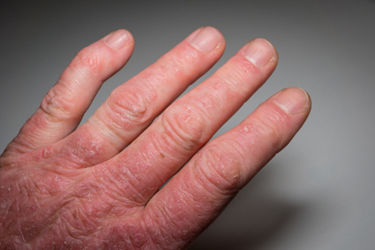Oral Therapies Take Center Stage For PsO And PsA Treatment
By Jack Gordon and Adam Pow, Lifescience Dynamics

The recent American Academy of Dermatology (AAD) 2025 Annual Meeting in Florida in early March saw major updates for two key oral therapies in autoimmune diseases: J&J’s icotrokinra and BMS’ Sotyktu (deucravacitinib). The drugs reported promising efficacy in moderate-to-severe psoriasis (PsO) and psoriatic arthritis (PsA), respectively, setting the stage for potential shifts in what are becoming increasingly crowded and competitive treatment landscapes.
Icotrokinra (JNJ-2113): Strong Phase 3 Performance And Head-to-Head Superiority Over Sotyktu
J&J presented late-breaking 24-week data from its Phase 3 ICONIC-LEAD trial of icotrokinra, an oral peptide interleukin-23 receptor (IL-23R) antagonist, in moderate-to-severe PsO. The results reinforced previously reported 16-week efficacy, with icotrokinra achieving a PASI-90 response in 64.8%, PASI-75 in 81%, and an IGA 0/1 response in 74.1% of treated patients (N=465) at W24. Safety findings remained consistent with previously reported Phase 2 data, showing a tolerable profile with no new safety concerns. However, perhaps the most significant revelation was J&J’s accompanying announcement that the Phase 3 ICONIC-ADVANCE trials of icotrokinra in PsO had also met their primary endpoints vs. placebo and had demonstrated icotrokinra’s superiority over BMS’ Sotyktu in key secondary endpoints at W16 and W24. Although numerical data was not disclosed, this positions icotrokinra as a potential best-in-class oral treatment in PsO.
While oral therapies offer improved dosing convenience and accessibility, icotrokinra did not seem to meet the holy grail of biologic-level efficacy with PASI-90 response rates (24W: 64.8%) falling short of IL-23 biologics like AbbVie’s Skyrizi (16W PASI-90: 75%) and J&J’s own Tremfya (24W PASI-90: 80%). Importantly, differences between icotrokinra vs. Skyrizi and Tremfya may not solely result from differences in the route of administration; by targeting the IL-23 receptor rather than the IL-23 cytokine, icotrokinra may achieve less broad immune modulation and possibly weaker therapeutic effect.
J&J is planning to initiate the Phase 3 ICONIC-ASCEND trial to compare icotrokinra directly against its own widely used IL-12/23 biologic Stelara (ustekinumab), which has recently lost exclusivity and is set for significant biosimilar erosion. Head-to-head data for icotrokinra against a biologic could be available around the time of a possible FDA approval in 2026.
Sotyktu Expands Indications With Strong Phase 3 PsA Data
As icotrokinra is strengthening its position in PsO, BMS continues to expand Sotyktu’s footprint beyond dermatology, despite its commercial performance largely failing to meet expectations in PsO. At AAD 2025, BMS presented Phase 3 POETYK-PsA-2 trial data evaluating Sotyktu in PsA. The trial, which enrolled both biologic-naïve and TNF inhibitor-experienced patients, met its primary endpoint, with 54.2% of Sotyktu-treated patients achieving an ACR20 response at W16 (vs. 39.4% for placebo). Key secondary endpoints, including ACR50 and PASI-75, also favored Sotyktu, demonstrating its efficacy in joint-related disease features. Importantly, Sotyktu showed a favorable safety profile compared to Amgen’s Otezla (apremilast), another oral PsA treatment, with lower rates of adverse events and treatment discontinuations. These findings strengthen BMS’ case for regulatory approval in PsA, with a U.S. approval possible as early as 2026.
Sotyktu, as a first-in-class TYK2 inhibitor, offers a distinct approach to targeting immune pathways compared to established biologics. Unlike IL-17 and IL-23 biologics, which directly block inflammatory cytokines, Sotyktu is thought to modulate immune signaling upstream, impacting multiple inflammatory pathways. This broad mechanism may offer an advantage in treating PsA, where joint and skin manifestations are likely to require comprehensive immune modulation. However, TYK2 inhibitors like Sotyktu face competition from JAK inhibitors, such as AbbVie’s Rinvoq (upadacitinib), which have shown strong efficacy in PsA and established solid market shares but suffer from a poorer safety profile, including black box warnings for serious infections, mortality, and major adverse CVS events.
Implications For The Oral PsO And PsA Markets
With an expected market entry for icotrokinra in 2026, positive head-to-head data vs. Sotyktu would likely enable it to carve out a position as leading oral therapy in PsO, as it competes with both Sotyktu and Amgen’s Otezla for market share. While Sotyktu was the first TYK2 inhibitor to enter the PsO market, its relative commercial underperformance and the entry of icotrokinra as a more effective oral alternative could further restrict Sotyktu’s room for growth in PsO and may force BMS to focus more on its expansion into PsA and other rheumatology diseases. Sotyktu’s strong performance in PsA underscores its versatility, and BMS is actively exploring further indications, including systemic lupus erythematosus (SLE) and juvenile PsA.
Beyond icotrokinra and Sotyktu, the PsO and PsA treatment landscapes are poised for further disruption with next-generation TYK2 inhibitors and novel mechanisms of actions advancing through late-stage development. Alumis’ ESK-001 and Takeda’s zasocitinib TYK2 inhibitors, both in Phase 3 development in PsO, are aiming to improve on Sotyktu’s efficacy and safety with greater selectivity and fewer off-target effects. Meanwhile, UCB’s Bimzelx, a dual IL-17A/F inhibitor, is building momentum following strong recent commercial launches in PsO (October 2023) and PsA (September 2024) and MoonLake’s sonelokimab, a next-generation IL-17A/F nanobody, recently entered Phase 3 in PsA, going head-to-head with the market leader in AbbVie’s Skyrizi in an attempt to establish a best-in-class profile.
Looking Ahead
As the field awaits further data readouts from the ICONIC and ADVANCE trials, key questions remain. Can icotrokinra truly achieve superior or comparable biologic-like efficacy vs. Stelara in a convenient oral formulation? Can Sotyktu carve out a leading role in PsA despite competition from biologics and JAK inhibitors? The coming months will provide greater clarity as both companies prepare for regulatory filings and potential label expansions. For now, AAD 2025 has solidified icotrokinra and Sotyktu as two of the most exciting oral treatments in the inflammatory disease space, with significant implications for both patients and the evolving treatment landscape.
About The Authors:
 Jack Gordon, Ph.D., is a business analyst with Lifescience Dynamics.
Jack Gordon, Ph.D., is a business analyst with Lifescience Dynamics.
 Adam Pow, Msc, is a consultant with Lifescience Dynamics.
Adam Pow, Msc, is a consultant with Lifescience Dynamics.
